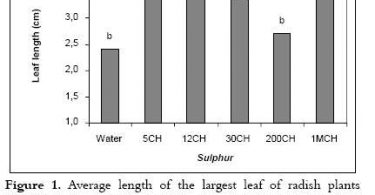Most people like to see some sort of validation of a product or service before they’ll embrace it, particularly where that product or service has had a significant amount of negative if not hostile treatment by the media. Homeopathy has had more than its fair share of criticism over the centuries as it was used around the world to relieve people of their illnesses. For potential new users of homeopathy, it may be of benefit to know that there is a large body of objective evidence for the practice of homeopathy, and some recent examples of this follow.
Human Studies
- Ferreri R, et al. The Clinical Experience in the Centre of Integrated Medicine, Pitigliano Hospital Using Magistral Homeopathic Formulations: Results in Outpatients Affected by Chronic Diseases and Considerations on the Chronic Care Model Integrated with Homeopathic Approach. Homeopathy, 2016, 105, 14. An Italian team recorded the outcomes of the treatment of people suffering from chronic ailments using homeopathically prepared combination products. Data from 1600 people were collected and assessed using the Edmonton scale, SF12, family and work performance evaluations. Broadly, the results were as follows. For recurrent respiratory syndromes, an averaged 85% reduction in the use of conventional therapies (antibiotics, anti-asthmatics, and corticosteroids) was seen. In people suffering from rheumatic disorders, reductions in pain were noted as well as a reduction in the use of conventional medicines. For those presenting with tinnitus an averaged reduction in symptoms of 45% was observed. Allergy sufferers experienced a 75-100% reduction in conventional medicine use and those presenting with chronic pain conditions (headache, migraine etc) reported reductions in pain ranging from 45-84%.
- van Heerden HJ, Razlog R, Pellow J. Pilot Study on the Homeopathic Treatment of Binge Eating in Males. Alth Ther in Health and Med, 2016, April, 22, Suppl 1:8-13. This work from the University of Johannesburg in South Africa sought to measure the efficacy of individualised homeopathic treatment for binge eating in adult males. A 3 week baseline period was used which was followed by a 6 week treatment period and assessment was carried using a self-assessment calendar (SAC), recording the frequency and intensity of binging, the Binge Eating Scale (BES), a psychometric evaluation of severity, and case analysis evaluating changes with time. 10 males who were diagnosed as binge eaters were prescribed individualised homeopathic treatment. The study found a statistically significant improvement with regard to the BES and the SAC, with a large effect size, indicating that a decrease occurred in the severity and frequency of binging behaviour during the study period.
- van Haselen R, et al. The Effectiveness and Safety of a Homeopathic Medicinal Product in Pediatric Upper Respiratory Tract Infections With Fever: A Randomized Controlled Trial. Global Pediatric Health, 2016, 3, 1–11. The authors of this study investigated the clinical effectiveness of a homeopathic add-on therapy in a paediatric subpopulation with upper respiratory tract infections (URTI’s). Patients received either on-demand symptomatic standard treatment (ST-group) or the same ST plus a homeopathic medication (Influcid; IFC-group) for 7 days. Outcome assessment was based on symptom and fever resolution and the Wisconsin Upper Respiratory Symptom Survey–21 (WURSS-21). A total of 261 children (<12 years) (130 IFC-group; 131 ST group) were recruited in Germany and the Ukraine. An analysis of the results of this research found that the IFC-group used less symptomatic medication, symptoms resolved significantly earlier, had higher proportions of fever-free children from day 3 onwards, and the WURSS-assessed global disease severity was significantly less during the entire URTI episode than the ST group.
- Grimaldi-Bensouda L, et al. Homeopathic Medical Practice for Anxiety and Depression in Primary Care: The EPI3 Cohort Study. BMC Complementary and Alternative Medicine, 2016, 16, 125.This French study compared the use of conventional psychotropic drugs among people seeking care for anxiety and depression disorders (ADDs) from general practitioners (GPs) who strictly prescribe conventional medicines (GP-CM), regularly prescribe homeopathy in a mixed practice (GP-Mx), or are certified homeopathic GPs (GP-Ho). Assessment was via the Hospital Anxiety and Depression Scale, HADS) as assessments were carried out at baseline, and at 1,3 and 12 months. 710 people who met the inclusion criteria participated in the study. The authors concluded that patients with ADD, who chose to consult GPs prescribing homeopathy reported less use of psychotropic drugs, and were marginally more likely to experience clinical improvement, than patients managed with conventional care.
- Rossi E, et al. Homeopathic Therapy in Pediatric Atopic Diseases: Short- and Long-Term Results. Homeopathy, 2016, 105, 3, 217-224. An Italian team studied the outcomes of atopic diseases (atopic dermatitis, atopic rhintis and asthma) in 857 children treated with homeopathy at the Homeopathic Clinic of Lucca (Italy) and related long-term results after approximately an 8-year period. The results showed that 75.8% of atopic children had moderate or major improvement (67.1% with asthma as the primary disease; 84.2% rhinitis; 84.2% dermatitis). At re-evaluation after 5-10 years, complete remission of atopic symptoms was obtained in 70.1% of the children: 84.2% in dermatitis; 48.1% in allergic rhinitis; 71.4% in asthma. Children with two or three atopic diseases at the first visit were completely cured in 40% of cases.
- Beghi GM, Morselli-Labate AM. Does Homeopathic Medicine Have a Preventive Effect on Respiratory Tract Infections? A Real Life Observational Study. Multidisciplinary Respiratory Medicine, 2016, 11, 12. The goal of this controlled observational study was to investigate the role of a homeopathically prepared medicine (Anas barb) in preventing respiratory tract infections (RTIs). The authors analysed data from 459 people suffering from RTI’s, 248 of whom were treated with Anas, and 211 were not treated. All were followed-up for at least 1 year, and up to a maximum of 10 years. A significant reduction in the frequency of onset of RTIs was found in both the homeopathic medicine group and the untreated group. The reduction in the mean number of RTI episodes during the period of observation versus the year before inclusion in the study was significantly greater in the homeopathic-treated group than in untreated patients.
In-Vitro Studies
- Lima LF. Comparison Between the Additive Effects of Diluted (rFSH) and Diluted/Dynamized (FSH 6 cH) Recombinant Follicle-Stimulating Hormone on the In Vitro Culture of Ovine Preantral Follicles Enclosed in Ovarian Ttissue. Compl Ther Med, 2016, Apr, 25: 39-44. This study compared 2 types of recombinant follicle stimulating hormone (rFSH)- diluted and homeopathically potentised, on in-vitro development of ovine follicles. In the first experiment, ovarian fragments were cultured for 1 or 7 days in α-MEM(+) in the absence or presence of different concentrations of diluted rFSH to determine the best concentration. In the second experiment, the effect of diluted and potentised rFSH (rFSH 6C), alone or in combination, was studied. In experiment 1, compared to control, 50ng/mL of diluted rFSH induced higher rates of follicular survival after 7 days of culture and higher percentages of growing follicles at day 1 of culture. In experiment 2, compared to controls, rFSH 6C induced higher follicular diameter and survival rate after 7 days and early follicle activation at day 1 of culture (P<0.05). Compared to diluted rFSH, rFSH 6C induced higher rates of follicle activation at day 1 of culture.
- Mondal J, Samadder A, Khuda-Bukhsh AR. Psorinum 6X Triggers Apoptosis Signals in Human Lung Cancer Cells. J Integr Med, 2016, Mar, 14, 2, 143-153. This controlled study was conducted to examine the in-vitro effects of the homeopathic medicine, Psorinum 6X, on cancer cells. Cancer cell lines, including A549, HepG2 and MCF-7, were exposed to homeopathically prepared Psorinum 6X or a control, and the outcomes assessed using a 3-(4,5-dimethylthiazol-2-yl)-2,5-diphenyltetrazolium bromide assay. The cell line that exhibited the greatest level of inhibition was selected and used in further assays to examine cell cycle arrest, cell death (apoptosis), generation of reactive oxygen species (ROS) and change in mitochondrial membrane potential (MMP), with assessment carried out by flow cytometry and fluorescence microscopy. Expression of several signal proteins related to apoptosis and cell survival were quantified with Western blotting and confocal microscopy. Further, circular dichroism (CD) spectroscopy was used to determine possible drug-DNA interactions, as well as the induction of conformational changes. The results showed that Psorinum 6X triggered apoptosis in A549 cells via both up-regulation and down-regulation of relevant signalling proteins, including p53, caspase-3, Bax and Bcl-2.
- Lee KJ, Yeo MG. Homeopathic Rhus toxicodendron Has Dual Effects on the Inflammatory Response in the Mouse Preosteoblastic Cell Line MC3T3-e1. Homeopathy, 2016, 105, 1, 42-47. A preosteoblastic mouse cell line, MC3T3-e1, was treated with different homeopathic potencies of Rhus tox and COX-2 mRNA and protein expression was examined using reverse transcriptase-polymerase chain reaction (RT-PCR) and immunoblotting. Additionally, nitric oxide (NO) generation was examined in LPS-induced MC3T3-e1 cells using a Griess reaction assay. The results showed that exposure to different potencies of Rhus tox increased the expression of Cox2 mRNA, with Rhus tox 30X showing the most prominent increase in mRNA expression. In addition, treatment with Rhus tox 30X significantly increased prostaglandin E2 (PGE2) release compared with other homeopathic potencies. NO generation was dramatically decreased in MC3T3-e1 cells after Rhus tox treatment co-stimulated with lipopolysaccharide. Generally, exposure to homeopathically prepared Rhus tox was associated with a modulation of inflammation in the cell population that was studied.
- Bigagli E, et al. Effects of Extreme Dilutions of Apis mellifica Preparations on Gene Expression Profiles of Human Cells. Dose-Response, January-March, 2016, 1-7. Using whole-genome transcriptomic analysis, the authors of this work investigated the effects of a wide range of homeopathic preparations of Apis mellifica on the gene expression profiles of human cells. RWPE-1 cells, a non-neoplastic adult human epithelial prostate cell line, were exposed to Apis preparations (3C, 5C, 7C, 9C, 12C, 15C, and 30C) or to controls for 24 hours. Non-exposed cells were also checked for gene expression variations. The results showed that even the most diluted solutions retained the ability to trigger significant variations in gene expression. Gene pathway analysis revealed consistent variations in gene expression induced by Apis when compared to non-exposed reference cells but not to reference solvent solutions.
Animal Studies
- Siqueira CM, et al. Homeopathic Treatments Modify Inflammation But Not Behavioral Response to Influenza Antigen Challenge in BALB/c Mice. Homeopathy, 2016, 105, 3, 257-264. Mice suffering from influenza were given an orally consumed homeopathically prepared material made from the influenza virus for 21 days and challenged subcutaneously with influenza hemagglutinin antigen (7 μg/200 μl) at day 21. At this point, flow cytometry and morphometry revealed significant changes in T and B cell balance after influenza antigen challenge but no statistically significant changes to behaviour were noted.
2.Canello S, et al. Bone Computed Tomography Mineral Content Evaluation in Chickens: Effects of Substances in Homeopathic Concentration. Homeopathy, 2016, 105, 92-95. An Italian team working with battery chickens reared in commercial poultry-sheds (which typically have difficulties with proper bone mineralisation) randomly assigned 96 of the birds into 4 groups. Each group were given standard feed with one homeopathically prepared substance (Symphytum 9C, Tricalcarea 4C, Tricalcarea 9C or Calc carb 30C) or a placebo, in order to assess the ability of the homeopathic compounds to increase the concentration of calcium hydroxyapatite in the sternal spongy bone tissue. The team measured the concentration of calcium hydroxyapatite in the sternums by means of a computed tomography (CT). The results provided by the researchers state that, when compared to placebo, the use of Symphytum was associated with an increase in mineralisation of 30%, Tricalcarea 4C by 36% and Calc carb by 63%.
(Robert Medhurst is the author of The Concordant Clinical Homeopathic Repertory, which was formed entirely from clinically confirmed remedies.)




